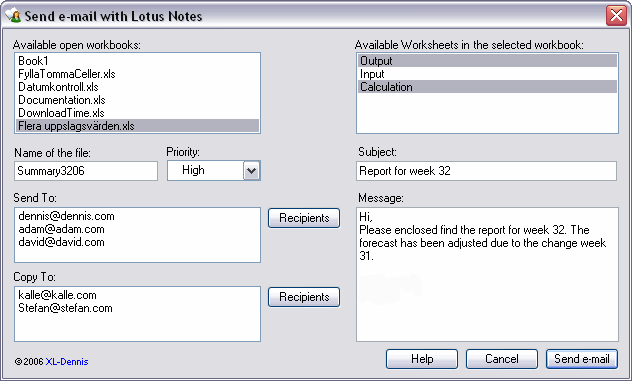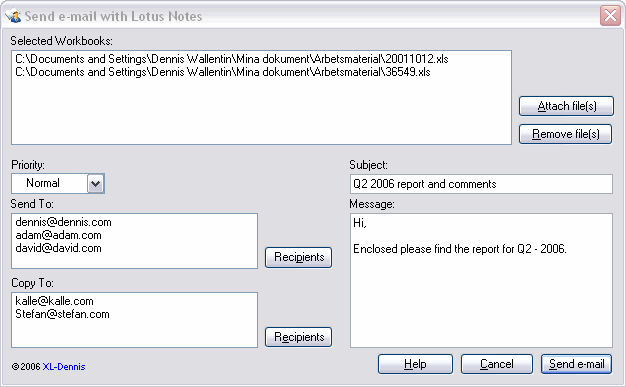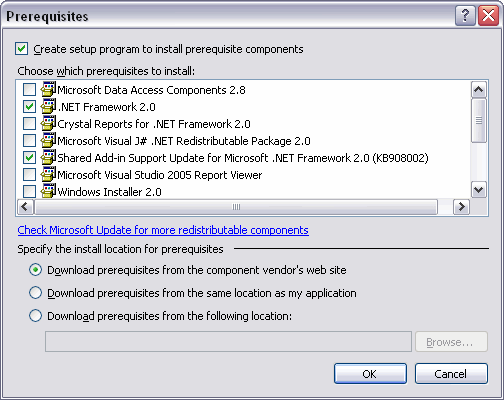Creating and deploying Managed COM add-ins with VB.NET 2005 – Part V
This is the fifth post on the subject and You can find the earlier post at the following links:
Part I – Introduction
Part II – Connection
Part III – Notes Tool -Workbooks
Part IV – Notes Tool – Worksheets
For all code posted here I have intentionally tried to avoid a) the core .NET-approach and b) the use of classes. Instead I have tried to focus on clarity and to use a simple classic VB/VBA -approach.
Notes Tool – The Functions
Below is all the functions and subs that are in a standard module (Notes.vb).
Imports Domino ‘To access the objects in the Domino class.
Imports Excel = Microsoft.Office.Interop.Excel ‘To access Excel’s objects.
Imports System.Windows.Forms ‘To use the Messagebox objects.
Imports System.IO ‘To handle files.
Imports System.Diagnostics ‘Open URL and show helpfile (.CHM)
Module NotesMod
‘Friend makes the variables available for the whole project.
Friend Const g_CONST_TITLE As String = “Send e-mail with Lotus Notes”
‘Excel variables.
Friend g_xlApp As Excel.Application
Friend g_xlRng As Excel.Range
Friend g_xlcell As Excel.Range
Friend g_xlwsSheet As Excel.Worksheet
Friend g_xlwbBook As Excel.Workbook
Sub Show_Help()
‘Show the helpfile.
Process.Start(My.Application.Info.DirectoryPath & “Notes_Tool.chm”)
End Sub
Sub Visit_Link()
‘Visit my english site.
Process.Start(“http://www.excelkb.com”)
End Sub
‘Function to add the selected worksheets to a new workbook.
Function Create_Save_Workbook(ByVal stBook As String, _
ByVal stName As String, _
ByVal alSheets As ArrayList) As Boolean
Dim stSheetItem As String
‘If the file already exist then delete the file.
If File.Exists(stName) = True Then File.Delete(stName)
‘Prevent the screen from flickering and surpress the message when deleting the worksheet.
With g_xlApp
.ScreenUpdating = False
.DisplayAlerts = False
End With
‘Add a new workbook with only one worksheet.
Dim xlNewBook As Excel.Workbook = g_xlApp.Workbooks.Add( _
Excel.XlWBATemplate.xlWBATWorksheet)
‘Grab the selected workbook from the form.
g_xlwbBook = CType(g_xlApp.Workbooks(stBook), Excel.Workbook)
‘Copy the worksheets to the new workbook.
For Each stSheetItem In alSheets
If Not (g_xlwsSheet Is Nothing) Then g_xlwsSheet = Nothing
g_xlwsSheet = CType(g_xlwbBook.Worksheets(stSheetItem.ToString), Excel.Worksheet)
g_xlwsSheet.Copy(After:=xlNewBook.Worksheets(1))
Next stSheetItem
‘Delete the first worksheet in the new workbook.
If Not (g_xlwsSheet Is Nothing) Then g_xlwsSheet = Nothing
g_xlwsSheet = CType(xlNewBook.Worksheets(1), Excel.Worksheet)
g_xlwsSheet.Delete()
‘Save the created workbook.
xlNewBook.Close(SaveChanges:=True, Filename:=stName)
‘Make objects available for the Garbish Collector.
If Not (g_xlwsSheet Is Nothing) Then g_xlwsSheet = Nothing
If Not (xlNewBook Is Nothing) Then xlNewBook = Nothing
If Not (g_xlwbBook Is Nothing) Then g_xlwbBook = Nothing
‘Restore settings.
With g_xlApp
.DisplayAlerts = True
.ScreenUpdating = True
End With
‘Set the status for the function to the calling sub.
Create_Save_Workbook = True
End Function
‘Function to create e-mail, add attachments and send.
Function Create_Email_Notes(ByVal stPriority As String, _
ByVal stSubject As String, _
ByVal oSendTo As Object, _
ByVal oSendCopy As Object, _
ByVal stMessage As String, _
ByVal bFlag As Boolean, _
Optional ByVal stFile As String = “”, _
Optional ByVal oFiles As Object = “”) As Boolean
‘Create and instantiate the Lotus Notes session.
Dim notSession As New Domino.NotesSessionClass
CType(notSession, Domino.NotesSession).Initialize(“”)
‘Open the local mail database.
Dim notMailDb As Domino.NotesDatabase = _
CType(notSession, Domino.NotesSessionClass).GetDbDirectory(“”).OpenMailDatabase
‘Grab the profile that holds the signature which will be added to the outgoing e-mail.
Dim notProfile As Domino.NotesDocument = _
CType(notMailDb.GetProfileDocument(“CalendarProfile”), Domino.NotesDocument)
‘Grab the signature, which only can be done with signatures in plain text.
Dim stSignature As String = CStr(notProfile.GetFirstItem(“Signature”).Text)
‘Create the outgoing e-mail.
Dim notDoc As Domino.NotesDocument = _
CType(notMailDb.CreateDocument, Domino.NotesDocument)
‘Create the body space in the outgoing e-mail.
Dim notItem As Domino.NotesRichTextItem = _
CType(notDoc.CreateRichTextItem(“Body”), Domino.NotesRichTextItem)
‘Create the attachment space in the outgoing e-mail.
Dim notAttach As Domino.NotesRichTextItem = _
CType(notDoc.CreateRichTextItem(“STFILE”), Domino.NotesRichTextItem)
‘Declare the variable for attached file(s).
Dim notEmbedded As Domino.NotesEmbeddedObject
If bFlag Then
‘Add the created Excel file as attachment to the outgoing e-mail.
notEmbedded = _
CType(notAttach.EmbedObject(EMBED_TYPE.EMBED_ATTACHMENT, _
“”, stFile), Domino.NotesEmbeddedObject)
Else
‘Add the selected Excel files as attachments to the outgoing e-mail.
Dim oItem As Object
For Each oItem In CType(oFiles, Array)
notEmbedded = _
CType(notAttach.EmbedObject(EMBED_TYPE.EMBED_ATTACHMENT, _
“”, CStr(oItem)), Domino.NotesEmbeddedObject)
Next
End If
Try
‘Populate the outgoing e-mail’s main properties.
With notDoc
.AppendItemValue(“Form”, “Memo”)
.AppendItemValue(“Subject”, stSubject)
.AppendItemValue(“SendTo”, oSendTo)
.AppendItemValue(“CopyTo”, oSendCopy)
.AppendItemValue(“DeliveryPriority”, stPriority)
With notItem
.AppendText(stMessage & vbCrLf & vbCrLf)
.AppendText(stSignature & vbCrLf & vbCrLf)
End With
.SaveMessageOnSend = True
.Send(True, “”)
End With
‘Set the status for the function to the calling sub.
Create_Email_Notes = True
Catch ex As Exception
MessageBox.Show(ex.ToString)
‘Set the status for the function to the calling sub.
Create_Email_Notes = False
Finally
‘Place variables to be handled by the Garbage Collector (GC).
notEmbedded = Nothing
notAttach = Nothing
notItem = Nothing
notProfile = Nothing
notDoc = Nothing
notMailDb = Nothing
notSession = Nothing
End Try
End Function
End Module
I’m not a person that get excited over code but I must admit that I’m pleased to have managed to get a workable solution with early binding to the Domino Class on the .NET platform. As far as I can see it shouldn’t be a problem to convert it to a classic VB function.
In the next post I will discuss ‘shimming’ managed COM add-ins and some important technical aspects.
Kind regards,
Dennis



